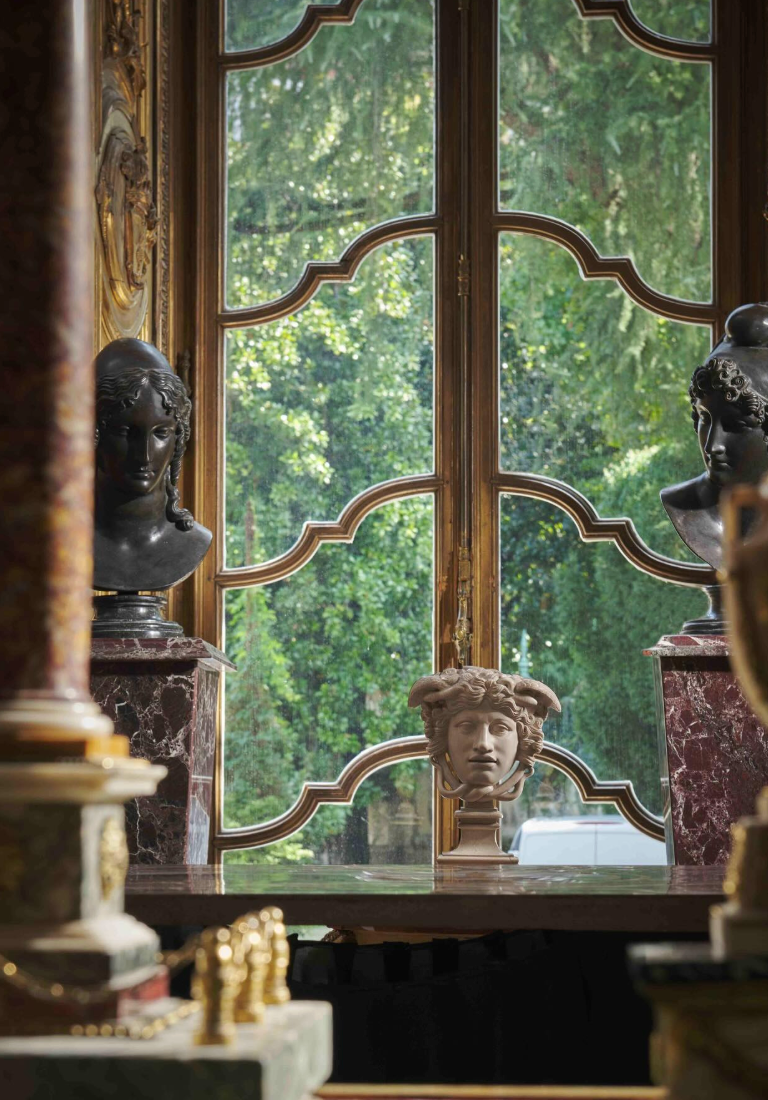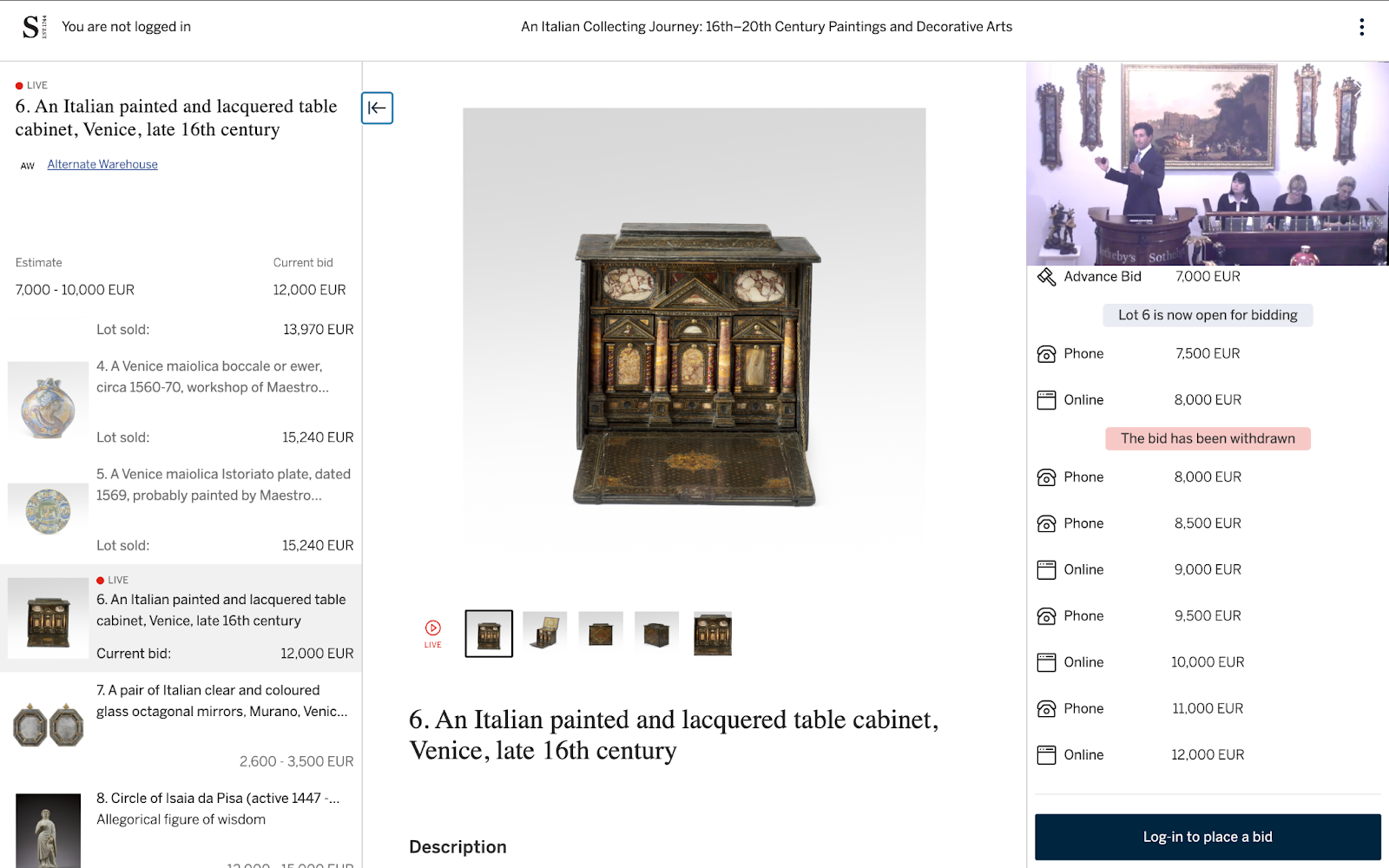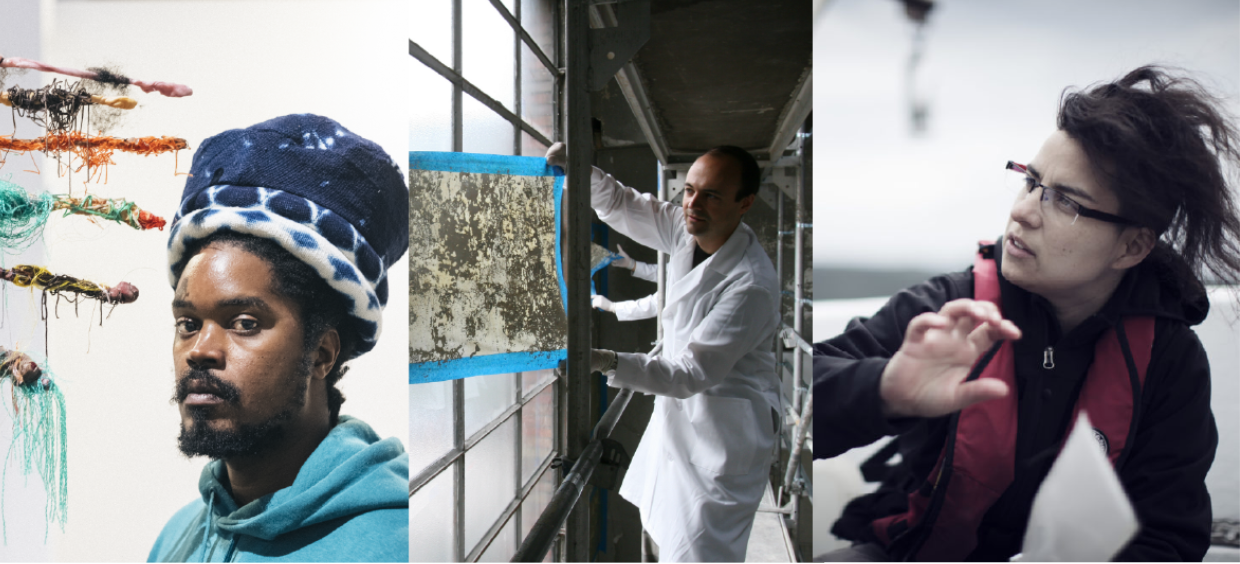An examination of artist Cai Guo-Qiang’s practice on the Himalayan Plateau, tracing the ethical tensions that shape the language of land art.
At 09:00 EST (15:00 CEST) on Wednesday, 25 September, the gavel tapped thrice on the rostrum at Palazzo Serbelloni, the home of Sotheby’s Milan. It was time to open the long-awaited live sale, An Italian Collecting Journey: 16th–20th Century Paintings and Decorative Arts. This afternoon’s sale, which lasted a little less than five hours, offered a diverse range of items, including Old Master paintings, decorative arts, and works of furniture, ceramics, and glass. With specialists and cataloguers from around the world working together to craft this journey through Italian fine and decorative arts over four centuries, there was no doubt that this impressive collection would yield magnificent results.
The auction overview on Sotheby’s website details that this sale “tells the story of Italy through its art.” With works representing four centuries of Italian History in the Early Modern and Modern periods, this “remarkable private collection” has “been chosen with scholarly rigor and a connoisseur’s eye, demonstrating an appreciation for quality, rarity, condition, and provenance.”
Within the collection, there is a Florentine tapestry from the Medici grand-ducal workshops, paintings by Pietro Fabris and Giovanni Battista Cimaroli, and ceramics made by the legendary Doccia Porcelain Factory. Beyond the names that an average art aficionado may recognize in these categories of fine and decorative arts, An Italian Collecting Journey presents a “cultural voyage” across time, style, geography, and various artistic collecting categories. In this sale, Italian history is told through “centuries of artistic creation,” as “a portrait of timeless creativity…that define[s] Italian art and continue[s] to inspire a sense of wonder across generations.”

We begin our Italian journey in Naples, the heart of Southern Italy and home to the wonders of the ancient Roman world. Here, Sotheby’s underscores Naples’ “striking presence” and “unforgettable cityscape” as the place where the intersection of “local identity and broader European currents” contributed to an “enduring quest for beauty and innovation.” The most exceptional highlight from Naples is Pietro Fabris’ 1777 painting, Naples, A View of Mergellina and the Palazzo Donn’anna Beyond, with Fishermen Drawing their Catch, Peasants Grilling Fish and Other Figures Conversing, oil on canvas, framed: 119.9 x 173.4 cm. (47¼ x 68¼ in). This painting is characterized as one of the artist’s “largest and most ambitious canvases” that “exemplifies his talent for blending the colourful aspects of daily life with his careful approach to the topographically accurate description of landscape.”

Our next stops on this journey take us to Turin and Venice. From Turin, the auction house highlights a magnificent lacquered and parcel-gilt cabinet-on-stand in the style of Pietro Massa (lot 73). This Piedmontese cabinet-on-stand has a secret mechanism that reveals drawers on the side, rather than the front, all of which are decorated with Chinoserie-style panels. This specific object is one that Mario Tavella, Chairman of Sotheby’s Europe (and of Major Collections) and President of Sotheby’s France, revealed, in an Instagram video, that he would bid on and purchase for his own collection. Tavella tells, in this video, that the cabinet-on-stand has a storied provenance (or ownership history) as it once belonged to the castle of the Bruni Tedeschi, the family home of Carla Bruni, the Franco-Italian singer/songwriter and former first lady of France, and her sister, the Franco-Italian actress and screenwriter Valeria Bruni Tedeschi.
From Venice, Sotheby’s presents its famous vedute, or views, as this city was “at the crossroads of East and West” and its artistic production embraces an “openness to foreign influences and a mastery of its own enduring traditions.” While the sale does not offer works from Canaletto’s masterful vedute of Venice, this private Italian collection includes other magnificent works by other artists whose skill brings the spirit of the Queen of the Adriatic to life, including Murano glass mirrors and a Vezzi teapot, circa 1725, both of which are “pioneering example[s] of Venice’s artistic innovation.”
The final stop of our journey takes us to the heart of the Italian Peninsula, Rome. Logically, the pieces from Rome in this private collection include exceptional examples of works created during the Italian Baroque, specifically the period of the Papal States. One object that stands out is an Italian painted and parcel-gilt table made by the circle of Gianlorenzo Bernini (the master sculptor of the papal court), and whose design is attributed to Giovanni Paolo Schor (the Austrian master decorator and close collaborator of Bernini).

Beyond the pieces made in the Early Modern Period, Sotheby’s also offers those made in the 20th century, including a bronze sculpture partly inspired by the bust of Antinous in the Vatican Museums by Vincenzo Gemito (1852-1929) and a globular vase by Gio Ponti titled La Venatoria – Trasporto del Daino and manufactured by Richard Ginori. As Sotheby’s writes in their note for both these pieces, as exemplars of the 20th-century object they offer in this sale, these works reemphasize that “the dialogue between past and present has always shaped Italian art,” whether it is Baroque understandings of ancient art or the uniquely Italian interpretations of the world (both local and global) around them.
One of the more interesting collections of objects includes those with the heraldic stemma, or coat of arms. Many of these stemma, as Gabriele Reina writes in his included essay, An Expert View on the Heraldic Collection, are “traceable and identified with families that not only played a major role in history, but were also eminent and, above all, discerning patrons of the arts.” These families include, but are not limited to, the Grimani (the Venetian patrician family), Farnese (the family of Pope Paul III), Medici (the banking family and political dynasty of the Florentine Republic), Frescobaldi (a Tuscan noble family), Borghese (Pope Paul V’s family and owners of Palazzo Borghese), and Stoppani (a noble family from Milan).

One of these objects (see Lot 364 in the image above) is part of the 1742 Service made for Marchese Brignole, of which there are only 5 known pieces in the world. With a robust section where specialists have noted its many references in art historical literature, the catalogue note attributes the striking red landscape painting to Carl Wendelin Anreiter (1702-1747), the Viennese gilder who headed the Doccia painting studio between 1737 and 1746, and cites a letter, written in 1742, from the chargé d’affairs of the Republic of Genoa at the Court of Tuscany to Carlo Ginori that confirms the delivery of this set.
Other highlights of this sale include a table made in late 18th-century Naples, which is inlaid with pieces of lavic stone (rather than hardstones as was done in Florence), a bucolic-themed Gio Ponti (1891–1979) vase, a tapestry with the Medici coat-of-arms, biscuit sculptures by Giovanni Volpato depicting the Barberini Faun, and a rare travel document holder with the Portuguese royal coat of arms, among many others.
In a video filmed for the Sotheby’s Instagram page, Mario Tavella deems the works of art offered for sale at Palazzo Serbelloni to be the “best private collection of Italian decorative arts ever offered by Sotheby’s. Ever.” Prompted by the videographer, Tavella takes us on his own Italian Collecting Journey, highlighting the various pieces that he would include in his own collection. At one point, he joked that he would need his own palace to include all the objects before sharing a rich history of Italian craftsmanship through the alluring details of his selected pieces.

Around 09:00 EST on Wednesday, 25 September, the sale’s auctioneer, Lorenzo Rebecchini (MD of Sotheby’s Italy and Head of Sales for Modern and Contemporary Art in Milan), made the traditional sale room notices and announcements before officially opening the live sale. After a fierce bidding battle between bidders in the room, on the phone, and online, the first lot of the morning—a Venetian glass enamelled footed bowl from the early 16th century—sold for €7,620 (~ $8,900) to an online bidder, a little over three times its low estimate of €2,000 (~ $2,300). This footed bowl was once the property of the Wunsch Foundation before it was previously sold at Christie’s London in their 6 December 2012 sale, The European Connoisseur, 500 Years Decorative Arts Europe. Sotheby’s catalogue note for this lot references two similar pieces to this lot in museum collections around the world, including a closely related ornament from a bowl in the Louvre (inv. nos. R9 and R15, with the latter from the Collection of Baron Salomon de Rothschild) and another from the Met (object no. 1975.1.1186).

Throughout the sale, there were moments of intense bidding, where bids would fly from the floor to the phone booths to the online bidders, whose bids would pop up on the screen in front of the auctioneer. As he effortlessly switched between English and Italian or conversed between his colleagues in his room and international clients online, Rebecchini’s quick reflexes and interjections for his audience to consider bidding the next interval up, many of the objects offered for sale flew above their high estimates, clearing the book entirely. With bids coming in from online and on the phone, the room felt electric as bidders tried to outcompete each other for these exceptional objects.
Thirty minutes into the sale, Lot 11, a Venice carved Istrian stone well-head with the coat of arms of the Donà family, late 15th century, reached a bid that was three times its low estimate of €6,000. As Rebecchini brought the hammer down on the rostrum, a pair of online bidders dramatically cut in, bidding €22,000 and €24,000 in rapid succession. With the momentum of the sale in mind, he decided to close the sale at €24,000 (hammer price), with the piece finally selling for €30,480 (~ $35,670), including Sotheby’s BP. Grazie mille per le sue partecipazione (thank you for your participation), Rebecchini said to the two online bidders as the final sale price was recorded, and he noted the winning paddle number.
E posso partire qua a €7,000…It’s at 7,000 euros with me. I took it in the room first del ragazzo alla mia sinistra…E contra di te Giorgio, it’s against you Giorgio!
Chloe Stead, Global Head of Private Sales for Old Masters Paintings from London, was actively bidding on behalf of one of her clients for a painting by the Flemish landscape painter, Jan Frans van Bloemen (called Orizzonte), titled An Italianate landscape with figures resting by ruins, the Colosseum in the distance. The bids flew between the room, the phone, and online, until finally Stead’s client put an offer that the online bidder had to refuse.
Con il signore al fondo di sala…a €4,200…a €4,500…a €4,800 grazie….Next will be €5,200. Grazie per la sua partecipazione.
A painting by the Circle of Caravaggio fetched over three times its low estimate. Giorgio Bowler, Specialist and Head of Day Sale for Old Master Paintings in London, was involved in a heated bidding battle with an online bidder, with bids that climbed €30,000 in two minutes. Rebecchini denied the request for a €2,500 increase, pushing Giorgio’s client to bid €100,000. Stuck at €95,000, Rebecchini held the hammer above the rostrum until Bowler’s client conceded, and he bid €100,000. Immediately, an online bidder fired back with a €110,000 (~ $130,000) offer. Thanking both for their patience, Rebecchini congratulated the online bidder on their win as the lot closed.
A few times during the sale, Rebecchini read the following saleroom notice: “Please note that this lot contains restricted materials. Sotheby's is not able to assist buyers with the shipment of any lots containing restricted materials into the U.S.A. The U.S. Fish & Wildlife Service reserves the right to block any export or import to the United States. A buyer’s inability to export or import these lots, or a seizure by a government agency, cannot justify any delay in payment or the cancellation of the sale.” Most of the lots that received this warning before he opened the bidding contained components from protected species, such as elephant ivory, tortoiseshell, or certain animal skins. As trade for these items is heavily regulated in the United States, Sotheby’s flags these items to ensure that any potential American buyer understands that the responsibility to secure proper permits (such as CITES) falls on the buyer. The final sentence, “A buyer’s inability to export or import these lots, or a seizure by a government agency, cannot justify any delay in payment or the cancellation of the sale,” means that, as Sotheby’s considers all sales to be legally binding from the moment the auction closes, the buyer must pay in full even if the US government seizes the item and it is never received.
And for the star lot of the sale, the lot estimated to be the highest with a low estimate €100,000, is Lot 94, Pietro Fabris’ vedute of Naples. After an intense, yet quick, two-minute bidding battle between Sotheby’s specialists on the landlines, the Fabris painting fetched €140,000 (~ $160,000) at hammer price, which totals €177,800 (~ $200,000) with Sotheby’s BP added on top. Other pieces, like lot 29 (A pair of Italian carved giltwood banquettes, Rome), lot 103 (A very rare Capodimonte porcelain figure of a mutilated soldier), and lot 104 (A Volpato biscuit porcelain figure of The Barberini Faun), fetched close to two to six times their low estimate.

After nearly five hours of bidding, the sale concluded with the offering of the final lot, lot 150, a pair of Italian painted and parcel-gilt chairs from the late 18th century, estimated between €1,500 and €2,000 (~ $1,760 to $2,300). While the specific results from this sale will be released at a later date, results on the Sotheby’s website gesture that the live sale fetched close to €4,100,000 (~ $4,800,000), pushing it a little over two times the live sale’s total low estimate of €2,013,260 (~ $2,355,048).
Even after the live auction concluded, Sotheby’s Milan is also presenting objects from this exceptional private collection in an online sale running between 17 and 26 September. The 235 lots in this sale will begin closing independently at 06:00 EST (12:00 CEST) on 26 September, so if there is something you have your eye on and were unable to bid in the live sale, make sure to bid before the sale closes. You do not want to miss out on this exceptional corpus of works that, as a whole, “stand as a testament to the enduring creativity of Italian artists and craftsmen, whose ability to reinterpret history has kept their work relevant, admired, and collected throughout the world.” As Mario Tavella himself wrote in a 21 September Instagram post, Che bello l’antico!
(Cover Image: An Italian Collecting Journey: 16th–20th Century Paintings and Decorative Arts, via Sotheby’s Milan)





